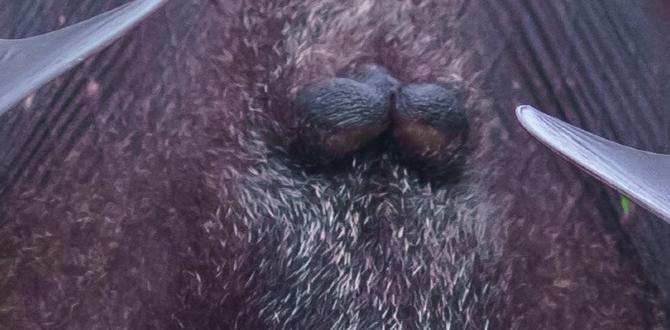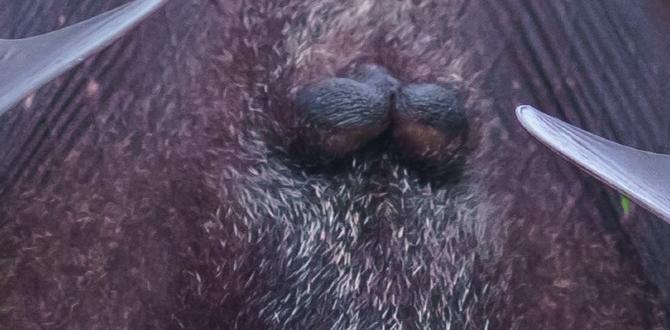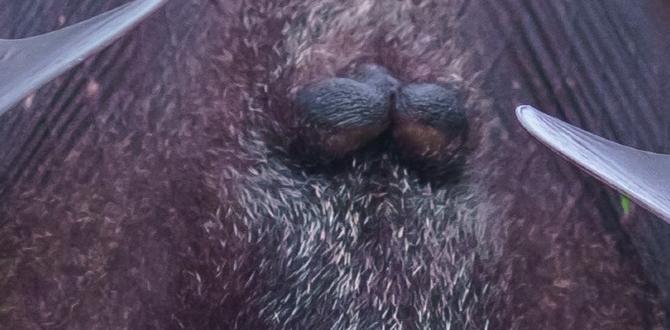Have you ever wondered what it’s like to fly in the night sky? Bats can do just that! These fascinating creatures are often misunderstood. Did you know that some bats can eat over a thousand insects in one night? That’s like a superhero saving the day by keeping pests away!
In this article, we will explore amazing bat facts for preschoolers. Bats are not spooky; they are super interesting! From their flying skills to their special echolocation, there’s so much to discover. Why do they hang upside down? What is their favorite food? Get ready to dive into the world of bats and see why they are so incredible!
Fun Bat Facts For Preschoolers To Spark Learning

Bat Facts for Preschoolers
Do you know bats can be friendly? These flying mammals play important roles in nature. They help pollinate flowers and eat insects. Isn’t that cool? Most bats are nocturnal, meaning they sleep during the day. Some can even live for over 30 years! Imagine a bat swooping by at night, using echolocation to find food. Learning fun bat facts can spark curiosity about our amazing world. Let’s explore more about these fascinating creatures together!What Are Bats?
Definition and basic characteristics of bats. Importance of bats in ecosystems.Bats are fascinating creatures! They are flying mammals, which means they are warm-blooded like us. They hang upside down and have wings made of special skin. These nocturnal animals use echo-location to find food. This means they make sounds that bounce off objects, helping them navigate in the dark. Bats are important for our ecosystems, too! They help control insect populations, pollinate flowers, and spread seeds. Who knew these little flyers did so much? A single bat can eat over 1,000 insects in just one night!
| Characteristic | Details |
|---|---|
| Type | Mammal |
| Wings | Made of skin |
| Diet | Insects, fruit, nectar |
| Role | Pollinator & pest controller |
Where Do Bats Live?
Common habitats of bats. How bats adapt to their environments.Bats are pretty clever little creatures. They love to hang out in lots of fun places! You can find them in caves, trees, and even old buildings. These furry friends are like nature’s ninjas, adapting to their homes with ease. Some bats choose cozy spots in caves for a secret nap, while others prefer tree hollows. Talk about being flexible! No wonder they’re the superheroes of the night!
| Common Bat Habitats | How Bats Adapt |
|---|---|
| Caves | Stay warm and safe from predators |
| Trees | Find food and hide from danger |
| Buildings | Use tiny spaces for roosting |
What Do Bats Eat?
Dietary habits of various bat species. The role of bats in controlling insect populations.Bats have different diets depending on the species. Some eat insects, while others prefer fruit or nectar. Insect-eating bats play an important role in nature. They help keep insect populations in check. Did you know a single bat can eat over 1,000 insects in one night? This helps farmers and keeps gardens healthy!
What do bats eat most?
Most bats eat insects, fruits, or nectar. Insect-eating bats are the best at controlling bug numbers!
Types of bat diets:
- Insect eaters
- Fruit lovers
- Nectar drinkers
How Do Bats Fly?
Explanation of bat anatomy and flight mechanics. Differences between bat flight and bird flight.Bats are amazing flyers! Their wings are special and made of stretchy skin. This skin connects their long fingers, which lets them flap and glide like pros. Unlike birds, bats can change directions quickly. Think of them as acrobats of the sky! While birds flap their wings straight up and down, bats swoop and dive with style. Did you know they can fly up to 60 miles per hour? Now that’s fast! With their unique flight, bats catch insects like a superhero, munching on pesky bugs!
| Bat Flight | Bird Flight |
|---|---|
| Flexible wings | Stiff wings |
| Long fingers | Shorter digits |
| Quick turns and dives | Gliding and soaring |
Fun Bat Facts for Kids
Interesting and entertaining facts about bats. Myths and misconceptions about bats.Bats are fascinating creatures! They can fly and help pollinate flowers. Did you know that some bats eat up to 1,000 insects in one hour? That’s amazing for keeping pests away! Many people think bats are scary or dangerous, but they’re usually shy. Here are some fun facts:
- Bats are the only flying mammals.
- Some bats can see better in the dark than we do!
- They communicate using sounds we can’t hear.
Don’t be afraid; bats play a big part in nature!
What are common myths about bats?
Bats are blind, and they suck blood. This is a common belief, but it’s not true! Most bats have good eyesight. Only a few types drink blood. Bats are really helpful to have around!
Why Are Bats Important?
Contributions of bats to pollination and seed dispersal. The ecological role of bats and their benefits to humans.Bats do some pretty amazing things! They help flowers grow by spreading pollen, just like friendly little gardeners. Some bats munch on fruit and then fly away, helping to plant seeds in new spots—nature’s own delivery service! This means bats are key for healthy ecosystems, which is great for humans too. The more bats around, the more yummy fruit we get. Plus, they eat pests like mosquitoes, so they keep our evenings peaceful—not batty at all!
| Contribution | Benefit to Humans |
|---|---|
| Pollination | Helps flowers grow. |
| Seed Dispersal | Plants new trees and fruits. |
| Pest Control | Keeps bugs like mosquitoes away. |
How to Help Bats
Ways to support bat conservation efforts. Creating batfriendly environments at home or school.Helping bats is fun and easy! You can make your home a bat-friendly place. Start by planting native flowers. They attract tasty bugs—bat snacks! You can also set up a simple bat house. This gives bats a safe place to sleep. If you have a school garden, consider placing a bat house there too!
| Bat-Friendly Ideas | Why It Helps |
|---|---|
| Plant native flowers | Attracts their favorite meals! |
| Create bat houses | Provides safe resting spots! |
| Reduce pesticides | Keeps bats healthy! |
By doing these things, you are helping bats and nature! Remember, happy bats mean fewer bugs—how’s that for a win-win?
Conclusion
In conclusion, bats are fascinating creatures! They can fly, use echolocation, and eat insects. You can learn more by reading books or exploring nature. Next time you see a bat, remember these fun facts. Let’s keep asking questions and discovering more about the world around us! Bats are cool friends in nature.FAQs
Sure! Here Are Five Related Questions About Bats That Are Suitable For Preschoolers:Bats are really interesting animals! They can fly and help plants grow by spreading seeds. Some bats eat insects, while others drink nectar from flowers. They use echolocation to find food in the dark. Isn’t that neat?
Sure, I can help with that! Please go ahead and ask your question.
What Do Bats Like To Eat?Bats have different diets based on their kinds. Some bats eat insects like flies and moths. Others enjoy fruits, nectar, or even small animals. You can find fruit bats munching on bananas or mangoes. So, bats have a variety of tasty foods they like!
Where Do Bats Like To Sleep During The Day?Bats like to sleep in dark, cozy places during the day. You can find them in caves, under bridges, or inside hollow trees. They hang upside down to rest. This helps them stay safe from predators. Bats sleep a lot so they can be active at night!
Can Bats See In The Dark?Bats can’t see in the dark like humans do. Instead, they use a special ability called echolocation. This means they make sounds that bounce off objects. By listening to the echoes, they “see” things around them, even in the dark! So, while they can’t see well with their eyes, they can “see” just fine using sound.
How Do Bats Help Plants And Flowers?Bats help plants and flowers by spreading pollen. When bats drink nectar from flowers, they pick up pollen on their fur. As they move to other flowers, they drop off the pollen. This helps flowers grow fruits and seeds. Without bats, some plants would not produce as many fruits!
What Sound Do Bats Make When They Fly?Bats make a chirping sound when they fly. This sound helps them find their way in the dark. They use it to see how far away things are. You might hear these tiny noises if you listen closely at night. Bats are pretty cool creatures!
{“@context”:”https://schema.org”,”@type”: “FAQPage”,”mainEntity”:[{“@type”: “Question”,”name”: “Sure! Here Are Five Related Questions About Bats That Are Suitable For Preschoolers:”,”acceptedAnswer”: {“@type”: “Answer”,”text”: “Bats are really interesting animals! They can fly and help plants grow by spreading seeds. Some bats eat insects, while others drink nectar from flowers. They use echolocation to find food in the dark. Isn’t that neat?”}},{“@type”: “Question”,”name”: “”,”acceptedAnswer”: {“@type”: “Answer”,”text”: “Sure, I can help with that! Please go ahead and ask your question.”}},{“@type”: “Question”,”name”: “What Do Bats Like To Eat? “,”acceptedAnswer”: {“@type”: “Answer”,”text”: “Bats have different diets based on their kinds. Some bats eat insects like flies and moths. Others enjoy fruits, nectar, or even small animals. You can find fruit bats munching on bananas or mangoes. So, bats have a variety of tasty foods they like!”}},{“@type”: “Question”,”name”: “Where Do Bats Like To Sleep During The Day? “,”acceptedAnswer”: {“@type”: “Answer”,”text”: “Bats like to sleep in dark, cozy places during the day. You can find them in caves, under bridges, or inside hollow trees. They hang upside down to rest. This helps them stay safe from predators. Bats sleep a lot so they can be active at night!”}},{“@type”: “Question”,”name”: “Can Bats See In The Dark? “,”acceptedAnswer”: {“@type”: “Answer”,”text”: “Bats can’t see in the dark like humans do. Instead, they use a special ability called echolocation. This means they make sounds that bounce off objects. By listening to the echoes, they “see” things around them, even in the dark! So, while they can’t see well with their eyes, they can “see” just fine using sound.”}},{“@type”: “Question”,”name”: “How Do Bats Help Plants And Flowers? “,”acceptedAnswer”: {“@type”: “Answer”,”text”: “Bats help plants and flowers by spreading pollen. When bats drink nectar from flowers, they pick up pollen on their fur. As they move to other flowers, they drop off the pollen. This helps flowers grow fruits and seeds. Without bats, some plants would not produce as many fruits!”}},{“@type”: “Question”,”name”: “What Sound Do Bats Make When They Fly? “,”acceptedAnswer”: {“@type”: “Answer”,”text”: “Bats make a chirping sound when they fly. This sound helps them find their way in the dark. They use it to see how far away things are. You might hear these tiny noises if you listen closely at night. Bats are pretty cool creatures!”}}]}





